Cephalonia
Cephalonia
Περιφερειακή ενότητα Κεφαλληνίας | |
|---|---|
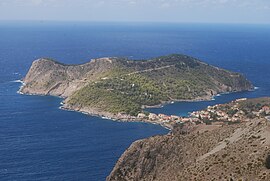 View ofAsos | |
| Coordinates:38°15′54″N20°33′09″E/ 38.26500°N 20.55250°E | |
| Country | Greece |
| Administrative region | Ionian Islands |
| Seat | Argostoli |
| Area | |
| • Total | 773 km2(298 sq mi) |
| Elevation | 1,628 m (5,341 ft) |
| Population (2021)[1] | |
| • Total | 36,064 |
| • Density | 47/km2(120/sq mi) |
| Time zone | UTC+2(EET) |
| • Summer (DST) | UTC+3(EEST) |
| Postal code | 280 xx |
| Area code(s) | 267x0 |
| Vehicle registration | ΚΕ |
| Website | www |
KefaloniaorCephalonia(Greek:Κεφαλονιά), formerly also known asKefalliniaorKephallenia(Κεφαλληνία), is the largest of theIonian Islands[2]in westernGreeceand the 6th largest island in Greece afterCrete,Euboea,Lesbos,RhodesandChios.It is also a separateregional unitof theIonian Islandsregion. It was a former Latin Catholic dioceseKefalonia–Zakynthos(Cefalonia–Zante) and short-livedtitular seeas just Kefalonia. The capital city of Cephalonia isArgostoli.[3]
History
[edit]Antiquity
[edit]Legend
[edit]
Anaitionexplaining the name of Cephallenia and reinforcing its cultural connections withAthensassociates the island with the mythological figure ofCephalus,who helpedAmphitryonofMycenaein a war against theTaphiansandTeleboans.[4]He was rewarded with the island ofSame,which thereafter came to be known asCephallenia.
Kefalonia has also been suggested as theHomeric Ithaca,the home ofOdysseus,rather thanthe smaller island bearing this name today.Robert Bittlestone, in his bookOdysseus Unbound,has suggested thatPaliki,now a peninsula of Cephalonia, was a separate island during the lateBronze Age,and it may be this which Homer was referring to when he described Ithaca. A project which started in the summer of 2007 and lasted three years has examined this possibility.[5]
Kefalonia is alsoreferencedin relation to the goddessBritomartis,as the location where she is said to have 'received divine honours from the inhabitants under the name ofLaphria'.
Archaic and Classical Periods
[edit]From at least the 6th century BC the island was dominated by four city-states (poleis):Pale(modern Lixouri),Cranii(mod. Argostoli),Same(mod. Sami) andPronnoi.[6]All four minted their own coins, as well as building monumental temples and fortifications, both in the cities themselves and in the surrounding countryside. Ancient writers generally paid little attention to the island throughout antiquity, but there are some notable references, and it seems that the Kefalonian cities were involved in developments and events across the wider Greek world. A certainMelampous,from Kefalonia, won the Lyre and Song contest at thePythian GamesatDelphiin 582 BC.[7]200 hoplites from Pale fought alongside other Greeks against the Persians in the decisive battle atPlataea,[8]and all four Kefalonian cities allied withAthensduring thePeloponnesian War.[9]The island was of strategic value to the Athenians, as it lies close to the entry to the Bay of Corinth. The Corinthians attempted, unsuccessfully, to attack Krane in 431 BC, and, 10 years later, Athens settled a group of Spartan deserters on the island.[10]Finally, a group of Kefalonian soldiers were recruited by the Athenian generalDemosthenesas part of the ill-fatedSicilian Expeditionin 415-413 BC.[11]
Hellenistic and Roman Periods
[edit]The Kefalonian cities retained close ties with Athens after the end of the Peloponnesian War, despite the Spartan victory. Athenian influence, including heavy direct taxation in the 4th century BC, may have been a stimulus for a new planned and fortified town at Same, which increasingly seems to have dominated the smallerpolisof Pronnoi.[6]
The Kefalonian cities once again contributed troops and ships to broader Greek military events, this timeAlexander the Great's invasion and conquest of thePersian Empire.In the subsequent centuries, the island was drawn ever close to theAetolian League.[6]As a result, it was invaded by the Macedonian kingPhilip Vin 218 BC[12]and then by theRoman republicin 189 BC, who conquered Same after a protracted siege.[13]From then onwards, Kefalonia lost its strategic importance, and so declined in social and economic terms. Archaeologically, the Roman period is dominated by lavish villas on the coasts, contrasted with little activity in the old towns.[6]The ancient links to Athens seem to have remained strong, as the emperorHadriangifted the island to the city during his reign.[14]
Middle Ages
[edit]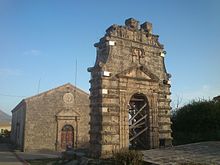
In the lateRoman Empire,Cephalonia was part of theRoman provinceofAchaea.Ecclesiastically it was a suffragan of theMetropolis of Nicopolis(the eparchy of Epirus I).[15]The four ancient cities of the island survived intolate antiquity,with Sami probably as the island's capital.[15]
Following the loss of the bulk of Italy, and the expansion of theMuslimsinto the Western Mediterranean, the island became a strategically important base of operations for theByzantine Empirein the area, blocking Muslim raids into theAdriaticand serving as a bridge for expeditions in Italy.[15]Already from the 8th century, it was the centre of the namesakethemeofCephallenia.[15]At the same time, the capital was moved to theCastle of Saint George,a more well-protected site in the island's interior.[15]Mardaiteswere resettled in Cephalonia to serve as marines, and political prisoners were sometimes exiled there.[15]
The loss ofByzantine Italyin 1071 diminished Cephalonia's importance, and its administration passed from a militarystrategosto a civilian judge (krites).[15]Its main city was besieged by theItalo-Normansin 1085, and theVenetiansplundered the island in 1126.[15]Cephalonia was captured during theThird Norman invasion of the Balkansin 1185, and it became part of theCounty palatine of Cephalonia and Zakynthosunder theKingdom of Sicilyand Venetian suzerainty, until its last CountLeonardo III Toccowas defeated and the island conquered by theOttoman Empirein 1479.[2][15]
Venetian rule
[edit]Turkish rule lasted only until 1500, when Cephalonia wascaptured by a Spanish-Venetian army,[2]a rare Venetian success in theSecond Ottoman–Venetian War.In the aftermath of the Venetian conquest, the island received an influx of civilian and military (stradioti) refugees from the lost Venetian fortresses ofModonandCoron,as well as many colonists from theVenetian-ruledisland ofCrete.[16]
From then on Cephalonia and Ithaca remained part of theStato da Marof theVenetian Republicuntil its very end, following the fate of theIonian islands,completed by the capture ofLefkasfrom the Turks in 1684. TheTreaty of Campoformiodismantling the Venetian Republicawarded the Ionian Islands toFrance,a French expeditionary force on ships captured in Venice taking control of the islands in June 1797.
Because of the liberal situation on the island, the Venetian governor Marc'Antonio Giustiniani (1516–1571) printedHebrewbooks and exported them to the whole eastern Mediterranean. In 1596 the Venetians built theAssos Castle,one of Cephalonia's main tourist attractions today. From the 16th to the 18th centuries, the island was one of the largest exporters ofcurrantsin the world withZakynthos,and owned a large shipping fleet, even commissioning ships from the Danzig shipyard. Its towns and villages were mostly built high on hilltops, to prevent attacks from raiding parties of pirates that sailed theIonian Seaduring the 1820s.
French, Ionian state period and British rule
[edit]
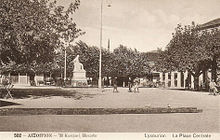
Venice was conquered by France in 1797 and Cephalonia, along with the other Ionian Islands, became part of theFrench départementofIthaque.
In the following year, 1798, the French were forced to yield the Ionian Islands to a combined Russian and Turkish fleet. From 1799 to 1807, Cephalonia was part of theSeptinsular Republic,nominally under the sovereignty of theOttoman Empire,but protected byRussia.
By theTreaty of Tilsitin 1807, the Ionian Islands were ceded back to France, which remained in control of Cephalonia until 1809. In 1809, theBritishestablished ablockadeon the Ionian Islands as part of their conflict with France, and in September of that year they hoisted theUnion Flagabove the castle of Zakynthos. Cephalonia and Ithaca soon surrendered, and the British installed provisional governments. TheTreaty of Parisin 1815 recognised theUnited States of the Ionian Islandsand decreed that it become a British protectorate. ColonelCharles Philippe de Bossetbecame provisional governor between 1810 and 1814. During this period he was credited with achieving many public works, including theDrapano Bridge,which later became known as the De Bosset Bridge, over the bay ofArgostoli.
A few years laterGreek nationalistgroups started to form. Although their energy in the early years was directed to supporting theGreeksin therevolution against the Ottoman Empire,it soon started to turn towards the British. By 1848, calls forenosiswith Greece were gaining strength and there were rebellions against British rule inArgostoliandLixouri,which led to some relaxation in the laws and to freedom of the press. Union with Greece was now a declared aim, and in 1849, as revolution was sweeping across Europe, a growing restlessness resulted in another rebellion against the British state, which was suppressed by the island's governor,Sir Henry George Wardwhen 21 people were hanged, several were shot and hundreds were flogged by the cat-o-nine-tails.[17]
Cephalonia, along with the other islands, were transferred to Greece in 1864 as a gesture of goodwill when the British-supported Prince William of Denmark becameKing George the First of the Hellenes.
Union with Greece
[edit]In 1864, Cephalonia, together with all the otherIonian Islands,became a full member of the Greek state.
World War II
[edit]

InWorld War II,the island was occupied byAxisforces. Until late 1943, the occupying force was predominantly Italian, the33rd Infantry DivisionAcquiplus Navy personnel totalled 12,000 men, but about 2,000 troops fromGermanywere also present. The island was largely spared the fighting, until thearmistice with Italyconcluded by theAlliesin September 1943. Confusion followed on the island, as the Italians were hoping to return home, but German forces did not want the Italians' munitions to be used eventually against them; Italian forces were hesitant to turn over weapons for the same reason. As German reinforcements headed to the island the Italians dug in and, eventually, after a referendum among the soldiers as to surrender or battle, they fought against the new German invasion.[citation needed]The fighting came to a head at the siege of Argostoli, where the Italians held out. Ultimately the Germans prevailed, taking full control of the island.
Approximately five thousand of thenine thousand surviving Italian soldiers were executedin reprisal by the German forces. The bookCaptain Corelli's Mandolinby Louis de Bernières, which was later made intoa film,is based on this event. While the war ended incentral Europein 1945, Cephalonia remained in a state of conflict due to theGreek Civil War.Peace returned to Greece and the island in 1949.[citation needed]
Earthquake of 1953
[edit]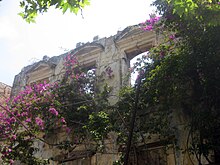
Cephalonia lies just to the southeast of a majoractive fault zone,where theEurasian Platemeets theAegean Plateat atransform boundary.The island itself is affected by a series of activethrust faults,which are responsible for the continuing uplift.
A series of four earthquakes hit the island in August 1953, and caused major destruction, with virtually every house on the island destroyed. The third and most destructive of the quakes took place on 12 August 1953 at 09:24 UTC (11:24local time), with a magnitude of 6.8 on theMoment magnitude scale.Itsepicentrewas directly south of the southern tip of Cephalonia, and caused the entire island to be raised 60 cm (24 in) higher, where it remains, with evidence in water marks on rocks around the coastline.
The1953 Ionian earthquakedisaster caused huge destruction, with only regions in the north escaping the heaviest tremors and houses there remaining intact. Damage was estimated to run into tens of millions of dollars, equivalent to billions ofdrachmas,but the real damage to the economy occurred when residents left the island. The majority of the population left the island soon after, seeking a new life elsewhere.
Recent history
[edit]
Theforest fireof the 1990s caused damage to the island's forests and bushes, especially a small scar north ofTroianata,and a large area of damage extending fromKateleiosnorth to west ofTzanata,ruining about 30 square kilometres (12 sq mi) of forest and bushes and resulting in the loss of some properties. The forest fire scar was visible for some years.
In mid-November 2003, an earthquake measuring 5.3 on theRichter magnitude scalecaused minor damage to business, residential property, and other buildings in and near Argostoli. The damage was around€1,000,000.
On the morning of 20 September 2005, an early-morning earthquake shook the south-western part of the island, especially near Lixouri and nearby villages. The earthquake measured 4.9 on the Richter magnitude scale, and its epicentre was located off the island at sea. Service vehicles took care of the area, and no damage was reported. From 24 to 26 January 2006, a major snowstorm blanketed the entire island, causing extensive blackouts. The island was recently struck yet again by another forest fire in the south of the island, beginning of 18 July 2007 during an unusual heatwave, and spreading slowly. Firefighters along with helicopters and planes battled the blaze for some days and the spectacle frightened residents on that area of the island.
In 2011, the eight former municipalities of the island lost their independence to form one united municipality. After losing its role as the capital of the island in the 19th century, Lixouri lost also its role as a seat of a municipality after 500 years. TheTechnological Educational Institute of the Ionian Islandsclosed one faculty in Lixouri and one in Argostoli.
In January 2014, an earthquake measuring 5.9 on theRichter magnitude scaleleft at least seven injured. There are reports of minor injuries and some damage to property, "said the Foreign Office, on its website." The airport remains operational but there may be some disruption to port services. "
Archaeology
[edit]
In the southwestern portion of the island, in the area ofLeivatho,an ongoingarchaeological field surveyby theIrish Institute at Athenshas discovered dozens of sites with dates ranging from thePalaeolithicto theVenetianperiod.
Cephalonia is extremely interesting archaeologically; finds go back to 40,000 BP. Without doubt, the most important era for the island is theMycenaean era,from approximately 1500 BC to 1100 BC. The archaeological museum in Cephalonia's capital, although small, is of great importance due to its exhibits from this era.
The most important archaeological discovery in Cephalonia (and indeed in Greece) of recent decades is that, in 1991, of the MycenaeanTholos tombat the outskirts ofTzanata,nearPorosin southeastern Cephalonia (former Municipality of Elios-Pronni) in a setting ofolive trees,cypresses, and oaks. The tomb was erected around 1300 BC; kings and highly ranked officials were buried insuch tombsduring the Mycenaean period. It is the largest tholos tomb yet found in northwestern Greece, and was excavated by archaeologist Lazaros Kolonas. The size of the tomb, the nature of the burial offerings found there, and its well-chosen position point to the existence of an important Mycenaean town in the vicinity.
In late 2006, a Roman grave complex was uncovered as the foundation of a new hotel was being excavated inFiskardo.The remains date to the period between the 2nd century BC and the 4th century AD. Archaeologists described it as the most important find of its kind in the Ionian Islands. Inside the complex, five burial sites were found, including a large vaulted tomb and a stone coffin, along with gold earrings and rings, gold leaves that may have been attached to ceremonial clothing, glass and ceramic pots, bronze artefacts decorated with masks, a bronze lock and bronze coins. The tomb had escaped the attention ofgrave robbersand remained undisturbed for thousands of years. When the tomb was opened the stone door easily swung on its stone hinges. ARoman theatrewas discovered very near the tomb, so well preserved that the metal joints between the seats were still intact.
A dissertation published in 1987 claims thatPaul the Apostle,on his way from Palestine to Rome in 59 AD, was shipwrecked and confined for three months not on Malta but on Cephalonia.[18][19]
According toClement of Alexandria,the island had the largest community ofCarpocratians,an earlyGnostic Christiansect, becauseCarpocrateslived on the island.
Population: historical evolution
[edit]In theancient period,the people lived in four cities on the island.Cranii,Sami(or Samos),PaleandPronnoi(Proni) formed a federation called "tetrapolis".[20]
In more recent times, the population reached 70,000, in 1896, but declined gradually in the 20th century. The great1953 Ionian earthquakeforced many people to leave the island.[21]Many of those who left moved to Patras or Athens, or emigrated to America and Australia, following relatives who had left the island decades before. In the same period people from poorer areas of Greece such as Epirus and Thrace came to the island. The population has hovered between 35,000 and 42,000 since then; in the 2011 census, it was 35,801.[22]
| Year | Population |
|---|---|
| 1879 | 68,321[23] |
| 1896 | 70,077[24] |
| 1920 | 55,030[25] |
| 1940 | 58,437[26] |
| 1961 | 39,793[27] |
| 1981 | 41,319[28] |
| 2001 | 34,544[29] |
| 2011 | 35,801[22] |
Most of the indigenous people of Cephalonia have surnames ending in "-atos", such as the Alexatos (Greek:Αλεξάτος) families, and almost every settlement on the island has a name ending in "-ata", such asMetaxata,Chavriata,Frangata,Lourdata,Favata, Delaportata and others.
Ecclesiastical history
[edit]In 1222 the Frankish Crusaders established the Diocese ofKefalonia–Zakynthos(Cefalonia–Zante in Curiate Italian), which survived their rule and even the Turks. In 1919, the residential see was suppressed but immediately transformed into atitular bishopricof Kefalonia (Cefalonia in Italian). The territory and title were merged into the MetropolitanArchdiocese of Corfu–Zakynthos–Kefalonia.In 1921, this was also suppressed, never having had an incumbent.
Geography
[edit]

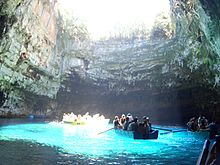
The main island of the regional unit is Cephalonia and has a size of 773 km2(298 sq mi), with a population density of 55 people per square kilometre (140 people/sq mi). The town ofArgostolihas one-third of the island's inhabitants.Lixouriis the second major settlement, and the two towns together account for almost two-thirds of the prefecture's population.
The other major islands are:Petalas IslandandAsteris Island,but they are uninhabited.
Cephalonia lies in the heart of anearthquake zone,and dozens of minor, unrecorded tremors occur each year. In 1953, amassive earthquakedestroyed almost all of the settlements on the island, leaving onlyFiskardoin the north untouched.
Important natural features includeMelissani Lake,the Drogarati caves, and theKoutavos Lagoonin Argostoli.
The island has a rich biodiversity, with a substantial number of endemic and rare species. Some areas have been declared a site in the European Union'sNatura 2000network.
Mountains
[edit]The island's highest mountain isMount Ainos,with an elevation of 1628 meters; to the west-northwest are thePalikimountains, whereLixouriis found, with other mountains includingGeraneia(Gerania) andAgia Dynati.The top of Mount Ainos is covered withfir treesand is a natural park.
Forestry is rare on the island; however its timber output is one of the highest in the Ionian islands, although lower than that of Elia in the Peloponnese.Forest fireswere common during the 1990s and the early 2000s, and still pose a major threat to the population.
Capes
[edit]- Cape Agios Georgios: approximate coordinates38°10′00″N20°26′00″E/ 38.1667°N 20.43333°E
- Cape Kounopetra
- Cape Atheras: north-western corner of island
Flora
[edit]Most of the Ainos mountain range is designated as aNational Park[30]and is covered with the rare species ofGreek fir(Abies cephalonica) and black pine (Pinus nigra).[31]
Fauna
[edit]Cephalonia is well known for its endangeredloggerhead turtlepopulation, also known as the Caretta caretta turtle, which nests on many of the beaches along the south coast of the island. The turtles can also be seen in the waters ofArgostoliharbour, inKoutavos Lagoon,while walking onDe Bosset Bridge.A small population of the endangeredMediterranean monk seal,Monachus monachus,also lives around the island's coast, especially on parts of the coast which are inaccessible to humans due to the terrain. Caves on these parts of the coast offer ideal locations for the seals to give birth to their pups and nurse them through the first months of their lives. The most famous breeding ground in Cephalonia is a cave on Foki beach, located on the north-east coast nearFiskardo.
TheEuropean pine martenalso inhabits the island.
Over 200 species of birds have been spotted on the island.[32]
Climate
[edit]Cephalonia has hot, sunny summers and mild rainy winters. According to theKöppen climate classificationsystem, it has a hot-summerMediterranean climate(Csa). During winter it can occasionally snow on the mountain peaks of the island's mountains. The winter months can experience up to 156 mm of rainfall, resulting in high levels of humidity on the island. Winter temperature on Kefalonia average at 14-15 °C during the day and 8-9 °C during the night. During the summer months there is usually little to no rainfall. Temperatures range from nearly 30 °C during the day to around 21 °C at night.
| Climate data for Argostoli (1981–2010) | |||||||||||||
|---|---|---|---|---|---|---|---|---|---|---|---|---|---|
| Month | Jan | Feb | Mar | Apr | May | Jun | Jul | Aug | Sep | Oct | Nov | Dec | Year |
| Mean daily maximum °C (°F) | 14.3 (57.7) |
14.1 (57.4) |
15.7 (60.3) |
18.5 (65.3) |
22.9 (73.2) |
27.0 (80.6) |
29.5 (85.1) |
29.9 (85.8) |
26.9 (80.4) |
23.5 (74.3) |
19.0 (66.2) |
15.5 (59.9) |
21.5 (70.7) |
| Daily mean °C (°F) | 11.3 (52.3) |
11.1 (52.0) |
12.3 (54.1) |
14.9 (58.8) |
19.7 (67.5) |
22.6 (72.7) |
25.1 (77.2) |
25.7 (78.3) |
23.0 (73.4) |
19.9 (67.8) |
15.9 (60.6) |
12.6 (54.7) |
17.8 (64.0) |
| Mean daily minimum °C (°F) | 8.3 (46.9) |
8.0 (46.4) |
9.0 (48.2) |
11.2 (52.2) |
14.5 (58.1) |
18.2 (64.8) |
20.6 (69.1) |
21.6 (70.9) |
19.1 (66.4) |
16.3 (61.3) |
12.8 (55.0) |
9.7 (49.5) |
14.2 (57.6) |
| Average rainfall mm (inches) | 93.1 (3.67) |
100.0 (3.94) |
66.6 (2.62) |
49.7 (1.96) |
20.4 (0.80) |
10.5 (0.41) |
1.3 (0.05) |
5.6 (0.22) |
31.3 (1.23) |
94.7 (3.73) |
155.9 (6.14) |
150.0 (5.91) |
779.1 (30.68) |
| Average rainy days(≥ 1.0 mm) | 9 | 9 | 9 | 5 | 3 | 1 | 0 | 1 | 3 | 7 | 11 | 12 | 70 |
| Source: Meteo-climat-bzh[33] | |||||||||||||
Economy
[edit]

Wineandraisinsare the oldest products exported, being important until the 20th century. Todayfish farmingandcalcium carbonateare most important.
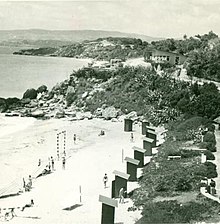
Most Greek ship-owner families have their origin in the islands of Andros, Chios or Cephalonia.[34]
Agriculture
[edit]The primary agricultural occupations areanimal breedingandolivegrowing, with the remainder largely composed of grain and vegetables. Most vegetable production takes place on the plains, which cover less than 15% of the island, most of which is rugged and mountainous, suitable only forgoats.Less than a quarter of the island's land isarable.
Until the 1970s, most Cephalonians lived in rural areas, while today, two-thirds of the population lives in urban areas, with the other third in rural towns and villages close to farmland.
The island has a longwinemakingtradition and is home to thedry,white lemony wines made from theRobolagrape.[35]
Olive oil production
[edit]Olive oil production is a major component of Cephalonia's economy. Until the 18th century, the quantity ofolive oilproduced on the island just covered the needs of the residents. However, the pressure ofVenetianconquerors' for olive plantation, especially after the loss ofPeloponneseandCrete,resulted in increasing the production to such a degree that the first exports to Venice began. Before the 1953 Ionian earthquake, there were 200 oil presses operating on the island; today, there are thirteen. There are over one millionolive treeson Cephalonia, covering almost 55% of the island's area. Olive oil is very important to the island's local, agricultural economy. "Koroneiki"and" theiako "are the two main varieties cultivated on the island, followed by a smaller number of" ntopia "and" matolia ". Kefalonian olive oil has a green tone, a rich, greasy touch, and low acidity.
Tourism
[edit]Tourismto Cephalonia started in the early 19th century. Theroyal family of Greecesent their children in the summerLixouri,in the early 20th century, but the island was not discovered by most tourists until the 1980s. Cephalonia is a popular holiday destination for many Italians, due to its proximity toItaly.[citation needed][36]
Two cultural attractions, the fishing villages ofFiscardoandAssos,and other natural attractions, includingMelissaniunderground lake,Drogaraticave andMyrtos beach,have helped popularize Cephalonia. The filmCaptain Corelli's Mandolin (film)(2001), filmed on the island, made Cephalonia more widely known. The film was mainly shot inArgostoli,Samiand on Antisamos Beach.[37]
Culture
[edit]
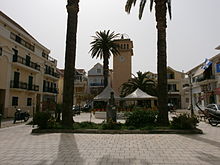

Monasteries and churches
[edit]Across the broader island, two largemonasteriesare to be found: the first is that of Haghia Panagia in Markopoulo to the southeast, and the other lies on the road between Argostoli and Michata, on a small plain surrounded by mountains. This second has an avenue of about 200 trees aligned from NW to SE, with a circle in the middle, and is the monastery ofSaint Gerasimus of Kefalonia,patron saintof the island, whoserelicscan be seen and venerated at the old church of the monastery. The monastery of "Sissia" was probably founded byFrancis of Assisi,it was destroyed in 1953 but the ruins still exist. Although much of the island was destroyed by earthquakes, many notable churches all over the island have survived, some dating back to the renaissance. The ornaments of the churches are influenced by Venetian manierism.
Music
[edit]
The Ionian Islands have a musical tradition called theIonian School.Lixouri has the Philharmonic Orchestra (since 1836) and Argostoli the Rokos Vergottis Conservatory.Richard Straussvisited Lixouri some times where he had an affair with the pianist Dora Wihan (born Weiss).
The Ionian Islands also developed a distinctive culture primarily as they did not experience Ottoman occupation, instead having ties to Venice, and musically drew from Italian influences, and Western Harmonics. This evolved into a unique musical style among the Greeks, the Cantada (Serenade) very similar to the Latin/Spanish/Italian Cantar (to sing). The Cantadas are an example of the Ionian music. Cantadas are still very popular and can be heard even today.
Literature and film
[edit]The novelistsNikos Kavvadias(1910–1975) and the SwissGeorges Haldas(1917–2010) spent parts of their life on the island.Andreas Laskaratoswas a satirical poet and wrote about the society in the town of Lixouri.Lord Byronwrote parts of "Prelude" and "Don Juan" in Livatho.
Additionally, a theory was proposed by Greek researcher Libieris Liberatos as to the true identity of the island setting from Shakespeare's "The Tempest"being Cephallonia.[38]
Perhaps the best known appearance of Cephalonia inpopular cultureis in the novelCaptain Corelli's Mandolin,by the English authorLouis de Bernières.The book is believed to have been inspired by the village ofFarsa,just outside Argostoli. The love story comprising the theme of the book is set before and after theAcqui Division massacre,[39]during the Second World War.A film adaptationwas released in 2001. During filming there was lively debate between theproduction team,local authoritiesas well as groups of citizens, as to the complex historical details of the island'santifascistresistance. As a result, political references were omitted from the film, and the romantic core of the book was preserved, without entering complex debates about the island's history. In 2005,Riccardo Milanimade his TV film,Cefalonia,also about the massacre, with music byEnnio Morricone.
Museums
[edit]- Korgialeneios Museum (under the Korgialeneios Library) in Argostoli
- Kosmetatos Foundation in Argostoli
- Archaeological Museum of Argostoli
- Iakovatios-Library (and museum) in Lixouri
- Museum in Fiskardo
- Kefalonia Natural History Museum
- Nautical Museum of Sami
Higher education
[edit]- Ionian University,Argostoli Campus (Department of Food Science and Technology[40]and Department of Digital Media and Communication[41])
- Ionian University,Lixouri Campus (Department of Ethnomusicology[42])
- NationalMerchant MarineAcademy, Argostoli
- The Music School of Kefalonia – Rokos Vergotis Conservatory, Argostoli
Sport
[edit]Baseball
[edit]- AINOS Kefalonia
Cycling
[edit]- AINOS Kefalonia podilatikos omilos 26710–25029
Football (soccer)
[edit]
|
|
|
|
Other sports
[edit]- Nautical Racing Club of Kefalonia and Ithaca
- Natura & Pet – Veterinary pharmacy
Transportation
[edit]
Harbours and ports
[edit]There are five harbours and ports in the prefecture and you can get to Kefalonia by boat: four main harbours on the island,Sami,a major port with links toPatrasandIthaca;Poros, in the south, has ferry routes toKyllini;Argostoli, in the west, is the largest port, for local boats and ferries toZanteand regularly to Lixouri;Fiscardo,in the north, has links toLefkasand Ithaca. There is room for about 100 small boats[43]in Argostoli, where the port stretches 1 kilometre around the bay, while Lixouri is situated 4 km (2 mi) across the bay from Argostoli, on the Lixouri peninsula. There is a road connection to the rest of the island, but driving from Lixouri to Argostoli involves a 30 km (19 mi) detour.
Roads
[edit]The first larger roads were built by the British in the 19th century. In the 20th century asphalted roads were built, and since 1995 almost all streets connecting villages and beaches are covered with asphalt. Since c. 2000 the Lixouri bypass was built and a four lane street south of Argostoli was constructed. Some important roads include:
- GreekNational Road50, commonly Argostoli-Sami Road
- Argostoli-Poros Road
- Argostoli-Fiskardo Road (with link to Lixouri).
- Road linking Poros and Sami
Public transportation
[edit]The ferry between Argostoli and Lixouri goes every hour and every half-hour in the season. There are a few bus lines serving the more rural areas of Kefalonia, but often only two times a day. TheKTEL bus cooperationoffers services from Lixouri, Poros and Argostoli to the mainland.
Airport
[edit]Cephalonia has one airport,Kefalonia Island International Airport,namedAnna Pollatou(IATA:EFL,ICAO:LGKF) with a runway around 2.4 km (1.5 mi). in length, located about 10 km (6 mi) south of Argostoli. Almost every scheduled flight is anOlympic Airroute, flying mainly to and from Athens, although there is an Ionian Island Hopper[44]service three times a week calling at Cephalonia,ZanteandLefkas.In summer the airport handles a number ofcharter flightsfrom all over Europe.
In December 2015 the privatisation of Kefalonia Airport and 13 other regional airports of Greece was finalised with the signing of the agreement between theFraport AG/Copelouzos Group joint venture and the state privatisation fund. "We signed the deal today," the head of Greece's privatisation agencyHRADF,Stergios Pitsiorlas, told Reuters. According to the agreement, the joint venture will operate the 14 airports (including Kefallinia International Airport) for 40 years as of autumn 2016.
Administration
[edit]Cephalonia is a distinctregional unitof theIonian Islandsregion, and since 2019 it consists of threemunicipalities:Argostoli,LixouriandSami.[45]Between the 2011Kallikratis government reformand 2019, there was one single municipality on the island: Cephalonia, created out of the 8 former municipalities on the island. At the same reform, the regional unit Cephalonia was created out of part of the formerCephalonia Prefecture.[3]The seat of administration isArgostoli,the island's main town.
The municipality of Argostoli consists of the following municipal units (former municipalities):
The municipality of Sami consists of the following municipal units:
The municipality of Lixouri coincides with the former municipalityPaliki.
The regional unit has an area of 786.575 km2.[46]The Cephalonia regional unit also includes a number of uninhabited islands of theEchinadesgroup. They are administered by the municipal unit of Pylaros. The most significant are as follows:
Notable people and residents
[edit]

- Antiquity
- Cephalus,hero-figure in Greek mythology, Patriarch of all Kephalonians (Cephallenians)
- Odysseusof Ithaca, king of the Cephalonians
- Epiphaneswas born on Cephalonia in the late 1st century or early 2nd century to Carpocrates (his father), and Alexandria of Kephallenia. He is the legendary author ofOn Righteousness,a notable Gnostic literary work that promotes communist principles.
- Gaius Antonius Hybrida,the uncle of the famed triumvir Mark Antony and co-consul of Cicero, who was exiled to Cephalonia in 59 BC.
- Middle Ages to 1800
- Juan de Fuca(Ioannis Phokas) (1536–1602), captain and explorer[51]
- Constantine Phaulkon(1647–1688), adventurer, first counsellor toKing Naraiof Ayutthaya[52]
- Giacomo Pylarini(1659–1718), doctor who gave the first smallpox inoculation outside of Turkey and contributed to the later development of vaccination against smallpox, by Edward Jenner.
- Ilias Miniatis(1669–1714), clergyman, writer and preacher. Born in Lixouri
- Leichoudes brothers,founders of theSlavic Greek Latin Academyin Moscow
- Andreas Metaxas(Greek:Greek:Ανδρέας Μεταξάς) (1786 – September 19, 1860), prime minister of Greece born on the island of Cephalonia.
- Spiridonos Louzis(Greek:Greek:Σπυρίδωνος Λούζης) (c. 1741–1815), Greek scholar, diplomat, politician and naturalized ambassador of Prussia.[50]
- Petros MelissinosGreek:Greek:Πέτρος Μελισσηνός)(c. 1726–1797) was a General of the Army of the Russian Empire and was widely considered the best Russian artilleryman of the 18th century.[53]
- 1800 to recent past
- Giovanni Carandino,also known as Ioannis Karandinos (Greek: Ιωάννης Καραντηνός) was a Greek mathematician and translator of the major French mathematical works in the early 19th century.
- Panayis Athanase Vagliano,Greek:Greek:Παναγής Βαλλιάνοςa.k.a. Panaghis Athanassiou Vallianos, (1814–1902) was a merchant and shipowner, acclaimed as the father of modern Greek shipping.
- Georgios Bonanos,sculptor (1863–1940)
- Nikolaos Xydias Typaldos(1826–1909), painter
- Photinos Panas,(January 30, 1832 – 1903) ophthalmologist, born on the Greek island of Cephalonia, Spartia. In 1860 he obtained his medical degree at Paris. He was the first professor of ophthalmology at the University of Paris, and in 1879 established the ophthalmology clinic at the Hôtel-Dieu de Paris.
- Ioannis Metaxas(April 12, 1871 – January 29, 1941), General, appointed Prime Minister of Greece between April and August 1936, and dictator during the 4th of August Regime, from 1936 until his death in 1941.
- Marinos Antypas(1872–1907), lawyer and journalist, one of the country's first socialists
- Christian Zervos(1889–1970) art collector, writer and publisher
- Mikelis Avlichos(1844–1917) Greek Anarchist
- Recent past to present
- Giorgos Kalafatis(1890–1964), founder ofPanathinaikos A.O.,his family descended fromDilinataof Cephalonia
- Spyridon Marinatos(1901–1974), archaeologist
- Antiochos Evangelatos(1903–1981), composer and conductor
- Dimitrios Loukatos(1908–2003),folklorist-anthropologistand specialist in Greek folklore.[54]
- Nikolaos Platon(1909–1992), archaeologist
- Nikos Kavadias(1910–1975), poet and author
- Gerasimos D. Arsenis,(1931– ) politician, former minister of Finance, Defense and Education.
- Antonis Tritsis(1937–1992), politician, mayor of Athens
- Archie Karas(1950–), aGreekgamblerknown for turning a ten thousand dollar loan into million dollars before losing it all
- Gerasimos D. Danilatos,physicist and inventor ofenvironmental scanning electron microscope
- Athanassios S. Fokas,Department ofApplied MathematicsandTheoretical Physics,University of Cambridge
- Richard Wright(1943–2008) from 1984 to 1994, keyboard player withPink Floyd
- Dionisios Vlachos(1964–present), chemical engineer, inventor and director
- Anna Pollatou(1983–2014) arhythmic gymnast;she won a bronze medal at the2000 Summer Olympics.
- Ellie Dimatos,(2007–present), female hockey player, won with team USA the2024 IIHF World Women's U18 Championship
Gallery
[edit]-
Church in Russian style, Antipata
-
Facade of Evangelistria church
-
Drogarati cave
-
Port of Argostoli
-
Street of Fiskardo
-
Assos
-
Belltower of the Monastery of Agios Gerasimos
-
St. Marina in Soullaroi (Illari)
-
Salad from Cephalonia (local name "pissara" )
In popular culture
[edit]Cephalonia (speltKephalloniain game) is the home ofAlexios and Kassandra,main characters of the videogameAssassin's Creed Odyssey(2018).[55]
The 1994 novelCaptain Corelli's MandolinbyLouis de Bernières,and the2001 film adaptation of the same name,are primarily set in Cephalonia.[56]
See also
[edit]References
[edit]- ^"Αποτελέσματα Απογραφής Πληθυσμού - Κατοικιών 2021, Μόνιμος Πληθυσμός κατά οικισμό"[Results of the 2021 Population - Housing Census, Permanent population by settlement] (in Greek). Hellenic Statistical Authority. 29 March 2024.
- ^abcChisholm, Hugh,ed. (1911)..Encyclopædia Britannica(11th ed.). Cambridge University Press.
- ^ab"ΦΕΚ A 87/2010, Kallikratis reform law text".
- ^Robert L. Fowler, 'The myth of Kephalos as aition of rain-magic' (Pherekydes FrGHist 3F34), inZeitschrift für Papyrologie und Epigraphik97(1993), pp. 29–42
- ^Gatopoulos, Derek (March 27, 2007)."Engineers to Help Find Homer's Ithaca".USA Today, Associated Press.Retrieved2007-03-28.
- ^abcdRandsborg, Klaus (2002)."Kephallenia Archaeology and History: The Ancient Greek Cities".Acta Archaeologica.73(2): 1–345.doi:10.1046/j.0065-001X.2002.00731.x.
- ^Pausanias 10.7.4.
- ^Herodotus9.28
- ^Thucydides 2.30
- ^Thucydides2.33,5.35
- ^Thucydides 7.31
- ^Polybius 5.3
- ^Livy 38.28-9
- ^Cassius Dio 69.16
- ^abcdefghiGregory, Timothy E. (1991). "Kephalenia". InKazhdan, Alexander(ed.).The Oxford Dictionary of Byzantium.Oxford and New York: Oxford University Press. pp. 1122–1123.ISBN0-19-504652-8.
- ^Pentogalou, Ger. I. (1980). "Εποικισμός της Κεφαλονιάς από κρητικές οικογένειες στα πρώτα χρόνια του ΙΣΤ′ αιώνα" [Colonization of Cephalonia by Cretan Families in the Early Years of the 16th Century].Πεπραγμένα του Δ' Διεθνούς Κρητολογικού Συνεδρίου, Ηράκλειο, 29 Αυγούστου - 3 Δεκεμβρίου 1976. Τόμος Β′ Βυζαντινοί και μέσοι χρόνοι(in Greek). Athens: University of Crete. pp. 412–425.
- ^"The English in the Ionian Islands".www.ionion.com.
- ^Loggerhead Turtles InAgnes Seppelfricke: Paulus war nie auf Malta
- ^"Hmc - St. Paul The Apostle".Imk.gr. Archived fromthe originalon 2017-08-18.Retrieved2013-03-26.
- ^Ripley, George; Dana, Charles Anderson (1860).The New American Cyclopaedia: A Popular Dictionary of General Knowledge.p. 654.
{{cite book}}:|work=ignored (help) - ^Odysseus Unbound: The Search for Homer's Ithaca – excerpt.Robert Bittlestone, Cambridge University Press, 2005. Page relating the account of a local to the 1953 great earthquake.
- ^ab 2011 Greek census:"Απογραφή Πληθυσμού - Κατοικιών 2011. ΜΟΝΙΜΟΣ Πληθυσμός".Hellenic Statistical Authority.(in Greek)
- ^ 1879 Greek census:Στατιστική της Ελλάδος. Πληθυσμός 1879(PDF).Athens:Ministry of the Interior.1881. Archived fromthe original(PDF)on 2018-05-08.(in Greek and French)
- ^ 1896 Greek census:Στατιστικά αποτελέσματα της απογραφής του πληθυσμού κατά την 5-6 Οκτωβρίου 1896(PDF).Athens:Ministry of the Interior,Public Economy and Statistics Section. 1897. Archived fromthe original(PDF)on 2018-12-16.(in Greek and French)
- ^ 1920 Greek census:Πραγματικός πληθυσμός της Ελλάδος κατά την απογραφήν της 19 Δεκεμβρίου 1920(PDF).Ministry of National Economy.1935. Archived fromthe original(PDF)on 2013-05-30.(in Greek and French)
- ^ 1940 Greek census:Πραγματικός πληθυσμός της Ελλάδος κατά την απογραφήν της 16 Οκτωβρίου 1940(PDF).Ministry of National Economy,General Statistical Service of Greece. 1950. Archived fromthe original(PDF)on 2014-10-24.(in Greek and French)
- ^ 1961 Greek census:Πραγματικός πληθυσμός της Ελλάδος κατά την απογραφήν της 19ης Μαρτίου 1961 κατά νομούς, επαρχίες, δήμους, κοινότητες και οικισμούς(PDF).National Statistical Service of Greece.1962. Archived fromthe original(PDF)on 2014-10-24.(in Greek and French)
- ^ 1981 Greek census:Πραγματικός πληθυσμός της Ελλάδος κατά την απογραφή της 5 Απριλίου 1981 κατά νομούς, επαρχίες, δήμους, κοινότητες και οικισμούς(PDF).National Statistical Service of Greece.1982.(in Greek and French)
- ^ 2001 Greek census:De Facto Population of Greece Population and Housing Census of March 18th, 2001(PDF).National Statistical Service of Greece.2003.
- ^"Ιστοσελίδα ΕΚΒΥ / Προστατευόμενες περιοχές".www.ekby.gr.Retrieved2016-09-26.
- ^"kefaloniainfo.net".www.kefaloniainfo.net.Archived fromthe originalon 2011-09-12.Retrieved2016-09-26.
- ^"Loggerhead Turtles In".Allkefalonia.com. Archived fromthe originalon 2013-06-09.Retrieved2013-07-23.
- ^"moyennes 1981/2010".
- ^Harlaftis, Gelina; Tsakas, Christos (2019)."The Role of Greek Shipowners in the Revival of Northern European Shipyards in the 1950s".Shipping and Globalization in the Post-War Era.Palgrave Studies in Maritime Economics. pp. 185–212.doi:10.1007/978-3-030-26002-6_8.ISBN978-3-030-26001-9.S2CID214118524.
- ^J. RobinsonJancis Robinson's Guide to Wine Grapespg 158 Oxford University Press 1996ISBN0198600984
- ^Das, Pankaj (Aug 13, 2023)."The best beaches in Kefalonia: 10 Must-Visit Coastal Wonders".dasstravelssolo.
- ^Greece, Kefalonia-all about this beautiful island in."Kefalonia Greece".Kefalonia Greece.Retrieved2023-09-14.
- ^"Shakespeare's Mistake" Libieris Liberatos
- ^"Cefalonia 1943".La Storia siamo noi. Archived fromthe originalon 2008-09-20.Retrieved2009-06-05.
- ^"DEPARTMENT OF FOOD TECHNOLOGY | Contact".fst.ionio.gr.
- ^"Contact | Department of Digital Media and Communication".
- ^"DEPARTMENT OF ETHNOMUSICOLOGY | Contact".ethnomus.ionio.gr.
- ^"kefalonia cruises".18 December 2020.
- ^ "Airsealines.com".www.airsealines.com.Retrieved2015-11-25.
- ^"Τροποποίηση του άρθρου 1 του ν. 3852/2010"[Amendment of Article 1 of l. 3852/2010] (in Greek).Government Gazette.p. 1164.
- ^"Population & housing census 2001 (incl. area and average elevation)"(PDF)(in Greek). National Statistical Service of Greece. Archived fromthe original(PDF)on 2015-09-21.
- ^Arnold, Charles.Die Inseln des Mittelmeers.(German.)
- ^Data fromGTP.Archived2010-07-04 at theWayback Machine
- ^abcΠροσδιορισμός και χαρτογράφηση των ορνιθολογικά ευαίσθητων στα αιολικά πάρκα περιοχών της Ελλάδας, Ελληνική Ορνιθολογική Εταιρεία (Griechische Ornithologische Gesellschaft)PDF Online[permanent dead link](1,883 MB), griechisch
- ^abKosch, Wilhelm (1959).Biographisches Staatshandbuch: Lexikon der Politik, Presse und Publizistik, Volume 1.Francke. p. 798.OCLC9227578.
Lusi, Spiridion Count of, born 1741 studied on the island of Cephalonia, who died in 1811, at Potsdam, educated at the Greek College in Venice, Padua
- ^Bernabeu Albert, Salvador (1995).Trillar los mares: la expedición descubridora de Bruno de Hezeta al noroeste de América, 1775.Editorial CSIC -CSIC Press.p. 32.ISBN9788400074593.
- ^WindowSeater (14 August 2017)."The Astonishing Story of Constantine and Maria of Lop Buri".Medium.com.Retrieved22 September2018.
- ^Masson, Charles François Philibert (1802).Secret memoirs of the court of Petersburg: particularly towards the end of the reign of Catharine II and the commencement of that of Paul I.T.N. Longman and O. Rees. pp. 339–340.OCLC35652011.
GENERAL MELISSINO – In these Memoirs we have frequently spoken of general Melissino, whose name will long live in Russia. He originally came from Cephalonia and prided himself on his Greek origin, which he was fond of recollecting.
- ^Folklore, April, 2004 by Thornton B. Edwards
- ^"Assassin's Creed: Odyssey put to the test".The Star.Petaling Jaya, Malaysia. 21 October 2018.Retrieved17 December2018.
- ^Mullan, John (2007-08-25)."Captain Corelli's Mandolin: the polyphonic novel".The Guardian.ISSN0261-3077.Retrieved2020-04-13.
Further reading
[edit]- Acta Archaeologica,volume 73/2 (December 2002) is a special issue dealing with the archaeology of Kephallenia.
- Fine, John V. A. Jr.(1994) [1987].The Late Medieval Balkans: A Critical Survey from the Late Twelfth Century to the Ottoman Conquest.Ann Arbor, Michigan: University of Michigan Press.ISBN0-472-08260-4.
- Leontsini, Maria (2014)."The Ionian Islands During the Byzantine Period: An Overview of their History and Monuments".In Hirst, Anthony; Sammon, Patrick (eds.).The Ionian Islands: Aspects of their History and Culture.Cambridge Scholars Publishing. pp. 26–63.ISBN978-1-4438-6278-3.
- Zečević, Nada (2014).The Tocco of the Greek Realm: Nobility, Power and Migration in Latin Greece (14th-15th centuries).Belgrade: Makart.ISBN9788691944100.
- Soustal, Peter; Koder, Johannes (1981).Tabula Imperii Byzantini, Band 3: Nikopolis und Kephallēnia(in German). Vienna:Verlag der Österreichischen Akademie der Wissenschaften.ISBN978-3-7001-0399-8.














